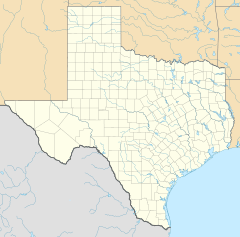Copeville, Texas facts for kids
Quick facts for kids
Copeville, Texas
|
|
|---|---|
| Country | United States |
| State | Texas |
| County | Collin |
| Elevation | 554 ft (169 m) |
| Time zone | UTC−6 (Central (CST)) |
| • Summer (DST) | UTC−5 (CDT) |
| ZIP Codes |
75121
|
| Area code(s) | 214, 469, 972 |
| FIPS code | 48-16600 |
| GNIS feature ID | 1333321 |
Copeville is a small, unincorporated community in Collin County, Texas, United States. An unincorporated community means it's a place with a shared identity but no local government of its own. It's part of the larger Dallas-Fort Worth Metroplex area. In 2000, about 106 people lived in Copeville.
Contents
Discovering Copeville's Past
Copeville was named after Miles Cope. He was one of the first people to settle in this area. The original town was about one mile west of where it is now.
Early Beginnings: 1850s to 1880s
In the 1850s, Miles Cope, along with his father and brother, helped organize the community. Thomas King officially planned and surveyed the town in 1877. A post office opened the very next year. By 1885, Copeville had several important businesses. These included a sawmill and a flour mill. There was also a church, a cotton gin, and a general store.
The Railroad's Arrival and Growth
In 1886, the Gulf, Colorado, and Santa Fe Railroad built its tracks. These tracks were about one mile east of Copeville. Soon, many people moved their homes and businesses closer to the train line. They wanted to benefit from the new transportation. Copeville became a busy shipping center for local farmers until the 1930s.
Between 1885 and 1890, Copeville also shipped a lot of bois d'arc timber to Dallas. This wood was being tested as a material for paving streets. In 1915, Copeville's population might have reached 300 people.
Challenges and Changes in Population
However, the town's growth slowed down. This was due to several big changes. The Great Depression (a time of economic hardship) affected many communities. Also, farming became more mechanized, meaning fewer people were needed for farm work. Plus, more job opportunities opened up in the bigger Dallas area.
The population estimate dropped to 240 in 1926. It stayed around that number through the 1920s and 1930s. By 1943, it decreased further to 150. This number remained steady until the early 1970s. In 1947, Copeville had five businesses and two churches. Between 1986 and 1990, there were seven businesses and 106 people. The population stayed at 106 in 2000. However, it grew to 243 people by 2010.
Tornadoes Affect Copeville
Copeville has experienced powerful storms. On October 4, 1959, an F3 tornado hit the community. Later, on the day after Christmas in 2015, an F2 tornado struck Copeville. This storm caused significant damage. A gas station and convenience store were completely destroyed. A large garage building was also ruined. Over 30 homes and businesses in the area were damaged, some very badly. Many people were injured during this event.
Where is Copeville Located?
Copeville is situated on Texas State Highway 78. It's near the eastern shore of Lavon Lake. The community is about 8 miles (13 km) southwest of Farmersville. It's also 21 miles (34 km) southeast of McKinney. Dallas is about 35 miles (56 km) northeast of Copeville. The community is also located on Farm to Market Road 1778, which is part of the Collin County Outer Loop.
Learning in Copeville
Copeville had its own school in both 1885 and 1947. Today, students in Copeville are served by the Community Independent School District. This district includes several schools. Younger students attend McClendon Elementary School. Middle schoolers go to Leland E. Edge Middle School. Older students attend Community High School.
Famous People from Copeville
Some notable individuals have connections to Copeville:
- Aubrey Otis Hampton: He was a radiologist, a doctor who uses imaging to diagnose diseases. He described medical conditions known as Hampton's hump and Hampton's line.
- J. Weldon Jones: He served as the acting High Commissioner to the Philippines.
- Charlie Walker: A country music artist. He was a member of the famous Grand Ole Opry.



